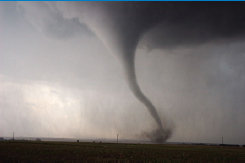Printed Page 1056
CHAPTER 15 PROJECTModeling a Tornado

1056
A tornado is a three-dimensional wind field that can be modeled as a velocity field. In this project we look at a two-dimensional slice of a vortex and use an Oseen vortex velocity field to model a tornado.
In rectangular coordinates, an Oseen velocity field is given by v=(Vmax
We place the center of the tornado at origin, where \mathbf{v} is undefined. Then \mathbf{v} gives the velocity of the wind at any other location within the vortex.
- Show that in the Oseen model, the speed (magnitude of the velocity) of the wind at any location is V_{\max }.
- Suppose V_{\max }=80{m}/{\!s}. Describe the velocity field at the following locations \hbox{(a) (0,-10), (b) \((-10,0)\), (c) \((0,10)\), (d) \((10,0)\), (e) \((10,10)\)}
- Add a few more vectors in the velocity field. What can you conclude about the direction of the wind?
A fluid, like the air in a tornado, is considered to be incompressible if the divergence of its velocity field, {div}\mathbf{v }, equals 0. When a fluid is incompressible, it is possible to find a function, \psi ( x,y) , called a stream function. The level curves of a stream function are called stream lines. These are the curves along which particles of fluid would flow. (You may have seen examples of stream lines such as air moving around a car in a wind tunnel.) The stream function, \psi ( x,y) , for a velocity field, \mathbf{v}=h( x,y) \,\mathbf{i}+g( x,y) \,\mathbf{j}, where h and g are functions of x and y, satisfies \dfrac{\partial \psi }{\partial y}=h( x,y) \quad\hbox{and}\quad \dfrac{\partial \psi }{\partial x}=-g( x,y)
1057
- Show that in the Oseen model, the air in a tornado is incompressible.
- Find a general form for the stream function of a stream line \psi ( x,y) =C for an Oseen velocity field.
- Suppose the speed V_{\max } of the wind in a tornado is 80 \rm{m}/{\!s} and the value of the constant C is 3200 \rm{m}^{3}/{\!s} (the units of C represent a volume flow rate). The air in the tornado is turning, and the twisting behavior of the velocity field can be quantified by a vector \mathbf{w}, called the vorticity. The vorticity at a point in space is a vector that is normal to the plane of rotation, and describes the amount of rotation about that point. The vorticity of a vector field is given by the curl of the vector field, curl \mathbf{v}. That is, \mathbf{w}=\rm{curl}~\mathbf{v}
- (a) Find the stream function and graph the stream line \psi (x,y)=3200.
- (b) Graph the stream lines for C=1000, 2000, 3000, and 4000.
- Find the vorticity \mathbf{w} of the Oseen velocity field. Interpret the result.
- In this project, we assumed the wind speed in the vortex was 80 \rm{m}/{s}. Research the Enhanced Fujita scale, or EF-scale, that is used to classify tornados based on the damage they cause. Rework Problems 2, 3, 6, and 7 for a tornado with a wind speed of 110 \rm{m}/{s} (an EF-5 tornado). Compare the results to a tornado with a wind speed of 80 \rm{m}/{s}.